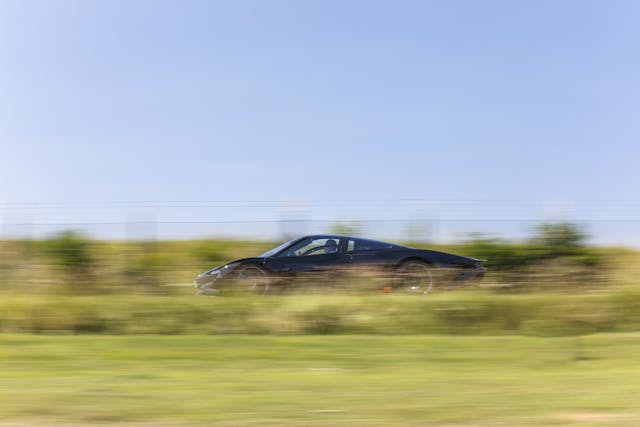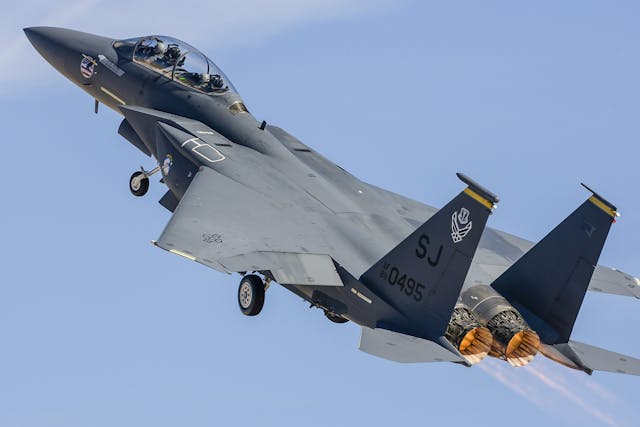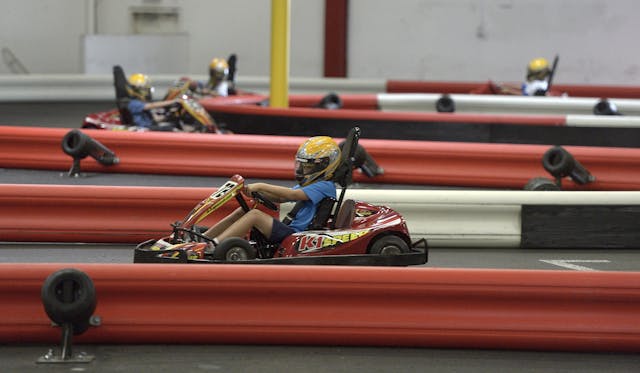Media | Articles
Our jet fighter pilot has some replacements for displacement
Selecting afterburner (AB) on a jet engine is roughly equivalent to dumping raw gasoline into a car’s exhaust, minus all the backfiring (hopefully). An afterburner is really good at doing two things. The first is incinerating liquified dinosaurs at a prodigious pace. The second isrocketing large, aerodynamic shapes through the air. (Unless we’re talking about the F-4 Phantom fighter jet, which was slightly less aerodynamic than my brick-on-wheels 1969 Jeepster Commando).
For those of you who are new here, this piece is part of a series from “Josh Arakes,” a senior U.S. military fighter-jet pilot who has obtained permission to share some of his life and experiences with us here at Hagerty. If you want to hear more about the Top Gun lifestyle, both as it relates to jets and cars, please let us know in the comments or by emailing tips@hagerty.com. Josh is willing to tell us anything that doesn’t compromise operational security. Enjoy! —Ed.
In my unusually meandering military career, I’ve been qualified in four different fighter jets. Most pilots are only ever qualified in one. Between the four jets are differences obvious to the casual observer, including number of engines/cockpits/vertical tails and overall size. Less obvious are the systems, sensors, avionics suites, switchology, and weapons they can carry/employ.
Tangent: You think some the music/nav/HVAC controls in your car are unintuitive? I’ll admit that pilot-vehicle interfaces have improved in this regard over time, but, like Einstein, you need not worry about your difficulties in navigating obscure menus; I assure you that mine are greater.
Configuring a fighter jet’s avionics for combat can be rather time-consuming. Thankfully, data cartridges allow for much of that to be done beforehand on computers and uploaded once in the aircraft. Still, there’s a lot of “hand jamming” of coordinates, sensor settings, weapons information, and more that pilot need to do. Some jets have gloriously simple menu/submenu setups, whereas other jet menus seem to be written in hexadecimal. Who are the ad wizards that came up with these?
Marketplace
Buy and sell classics with confidence
Secondary tangent: Most cars today feature a steering wheel with buttons. Some of those buttons control hands-free phone calls, others operate cruise control, media, and displays. Fighter jets are similar in that there are many switches and buttons on the stick and throttle(s), also known as Hands On Throttle And Stick (HOTAS). HOTAS allows the pilot to cue sensors and weapons, talk on the radio, change displays, shoot missiles/bullets and drop bombs, all without removing their hands from either the throttle(s) or stick. The benefit of such a system should be obvious, especially when compared to the aircraft of Korean and Vietnam War eras, in which pilots would miss opportunities to shoot down enemy aircraft because their jet was configured to drop bombs on a target and it took too long to reconfigure their systems. Current fighter jet HOTAS allows me to switch, essentially instantaneously, from dropping bombs to shooting down an enemy aircraft or vice-versa. There’s always the option of staying in bomb dropping mode and hope you score the one-in-a-million shot of your bomb hitting a flying aircraft, though that’s not in any tactics manual I’m aware of.

Unsurprisingly, multiple Top Gear variants/hosts popularized the idea of supercars either outright outrunning fighter jets or nearly doing so. I’ll admit to having watched the videos. They make for good TV. But let’s think about this subject for a moment: In one delightfully absurd clip, a British F-35 races a McLaren Speedtail around an airfield course. McLaren’s specs say the car weighs 3521 pounds, the twin-turbo V-8 produces 1036 horsepower, and it will hit 186 mph in 13 seconds. Per the U.K.’s Royal Air Force (RAF) fact sheet, an F-35B has a maximum takeoff weight around 60,000 pounds—undoubtedly, that’s with full fuel and a combat load of munitions.
Here’s where it gets tricky. the RAF tells us the F-35B’s engine is rated to 40,000 pounds of thrust; I’ve only ever seen jet engines rated by pounds of thrust (measurement of force), and there’s no easy conversion from that to horsepower (measurement of power). The issue is that trying to equate a force to a power (force times distance divided by time) just no workie. I’m sure jet engine manufacturers could tell you the shaft horsepower of the engine, but that would be a meaningless number. All that to say, trying to compare engine displacement/output/whatever between cars and jets is a fool’s errand.
That said, much like with a car, more power is always better with a fighter jet. A thrust-to-weight ratio of better than 1:1 means the jet can be vertical like a rocket and accelerate uphill; that’s awesome but not many jets, if any, can do that, especially when combat-loaded.

Furthermore, AB ignition (yes, we’re back to afterburners) isn’t instantaneous. With exhaust gas temperatures at military power (highest thrust setting below AB) in excess of 800° Celsius and moving hundreds of miles per hour, not to mention fan blades rotating at many thousands of rpm, you can’t just dump raw fuel into the exhaust and expect everything to be good. Without bogging you down into too many details, here’s how it goes: As the throttle jockey jockeys the throttle(s), the exhaust nozzle varies in diameter to regulate the pressure inside the engine. When moving the throttle(s) from idle to military power, the nozzle closes down; conversely, when moving from military into AB the nozzle opens back up. Thus, jet engines ignite their afterburners in stages over the course of a few seconds (you can feel them incrementally ignite; note that there’s a range of power settings in AB, it’s not a binary choice of full AB or no AB), thereby ensuring the engine doesn’t compressor stall and/or just flame itself out.

When I was high school, my dad’s daily driver was an early-’90s Saab 900. It was the first car with turbo I’d ever driven and the turbo lag was something to behold. Smartphones weren’t a thing then so there wasn’t anything inside the cabin at which to stare while driving other than the turbo gauge. (Kidding. Ish.) I remember the needle on the Saab’s turbo gauge indicating the building boost and when the needle transitioned from the white to yellow section the car leapt forward. If you’re looking for exact numbers on how long it took to build boost, you’re in the wrong place. Anecdotally though, I’d estimate the turbo lag was long enough to pop my Yes Union cassette out of the tape deck, grab my portable CD player, insert Midnight Oil’s Blue Sky Mining CD, plug the car cassette adapter into the CD player’s headphone jack, and then put the adapter cassette into the tape deck.
AB ignition is nowhere near that slow, but the instant torque from electric motors, like those found in the aforementioned Speedtail, leave both my jet’s AB response and Saab turbo lag in the dust. Which is why electric go karts are so much fun.

A few weeks back some friends put together a couples group date to a nearby electric go kart place. We had ten total couples, some of us good friends, some just acquaintances, and some I hadn’t ever met. The plan was to do a guys’ race, a gals’ race, then half the couples in a heat and the other half in another, thereby enabling everybody to race twice, if they wanted to.
The couple that set it up went frequently to this track and know it well. The husband teaches middle school science, is delightfully nerdy, and used his skills to build a spreadsheet into which each racer would enter their time and at the end of the evening it would spit out the fastest male, female, and couple, for which the organizers had prizes (the organizing couple raced but recused their times from winning consideration). Naturally, as the fighter pilot I was confident I’d win, but I was told there was an actual race car driver in the group. So I held off on talking trash. At first.
With these races it’s all about the fastest single lap, not who finishes first. There were about 14 laps per race, totaling less than 5 minutes of track time per heat, so if you get randomly dropped into a car at the back of the pack it’s tough to move to the front in such a short amount of time. Naturally, there’s a dude watching the races who shuts the cars down the moment there’s a spinout or crash; however, I noticed during the course of our guys-only race that as we raced cleanly the available power would bump up (there were a couple times I had been going flat out and the kart abruptly accelerated, leading me to that conclusion) so I think he could giveth and taketh away power. Anticipating this after a few laps, I worked my way free of surrounding karts and when the thrust bump hit I had about a lap and a half with critically minimal interference from other karts. As we climbed out of our karts after the race, still ignorant of the results, I heard one of the women say, “Of course the fighter pilot won.” I found the scoreboard and confirmed what I had heard; my fastest lap was 21.498 seconds, .226 seconds ahead of the race car driver (talking to him later, he was visiting from out of town and tests cars for an OEM on their track, so not strictly a race car driver), and about half a second off from being in the running for fastest lap of the week. Not bad for my first time on the track, if you ask me.
Like any good husband, I pulled my wife aside before her heat and talked her through the course and the karts. When the ladies started driving they were going pretty slowly. Turned out that one of them didn’t like driving at all, let alone karts, so she kept it pretty slow (and happened to be initially placed in the lead car). After a lap or so the race watcher guy, convinced there was something wrong with her car, stopped the drivers and brought her a new car. None of us that know her were surprised when she continued driving at the same pace in the new car; race watcher dude seemed to catch on and just let ‘em go, though he never bumped up their power like he did for us. I kept the slips from my two heats but my wife didn’t keep hers (strange, I know), so while I don’t have her times I know she wasn’t the fastest but she had been competitive.
For the next heat my wife and I were racing against four other couples. My wife was faster this second time, likely due to not having a competitor going 25 percent as fast as everybody else gumming up the works (the lady who didn’t enjoy driving did not do her second race). My fastest lap in the second round was eight tenths slower than my first attempt’s best lap and only good for second place in the heat. I zipped around most people, but there was one woman who caused me no end of frustration and, as seen on the slip, slowed me significantly. I outweighed her by 40+ pounds, so while I was driving a better line her lighter weight allowed her to stay just in front of me. I wasn’t a total jerk (at least initially), but there were several turns where I was steadily passing her and she’d just swerve in front of me; I’d brake so as not to hit her and then quickly catch up again. There’s no way she didn’t see me but, props to her, she just wasn’t letting me by.
After a couple laps of this, I decided not to brake when she swerved. It turned into the perfect self-inflicted pincer spinout across my front bumper, leaving her stopped in the middle of the track, 180° out. Race watcher guy slowed us down, cleared the mess, and with my impediment removed my subsequent laps were faster. When I approached her afterwards she wasn’t aware that I was “that guy”, but she wasn’t mad at me; more importantly, her giant tough-guy skater husband wasn’t either (they’re both great friends of ours so I wasn’t really worried).
In the end, I was the fastest male driver, my wife was the fastest woman (excluding the wife of the hosting couple), and we were the fastest couple. It’d be fun to go back to the course with our kids, but with minimal time left before our cross-country move it’ll have to wait until our new duty station (there’s a track in town there; I’ve already looked).
Is there really no replacement for displacement? I’m not sure that strictly applies to electric motors, but in my fighter jet I’m more concerned about how veritably plethoric the number of thrusties exiting the exhaust is than pure displacement. (I couldn’t tell you the displacement of any jet engine I’ve ever flown). While any supercar, minivan, and the karts in which my wife and I were victorious would beat my fighter jet off the line (not sure my Jeepster should be included in this conversation), I’ll keep my fighter jet. As I rocket past you with a massive 25-foot-long flame spitting out my tail end, I’ll pull 6+ g to stand the jet on its tail and zorch off to the moon. Reaching the end of the runway, you’ll bring your car to a stop, climb out, and, with jet noise rumbling across the sky and through your soul, you’ll try (and fail to visually) reacquire me, not realizing I’m already four miles up. And still climbing.
Sadly, though I’ll still be on active duty, my new assignment is a flying job that doesn’t involve jet engines. Thus, by the time you read this, I will have had my last flight with a fighter jet strapped to me, at least for the foreseeable future. I can’t begin to describe the honor it’s been to pilot these incredible machines for so many years and to employ them in defense of our great nation. Without question I’ll miss slipping the surly bonds of Earth, as John Gillespie Magee, Jr. so eloquently put it … but I’ll settle for smoking all comers on the kart track!

















